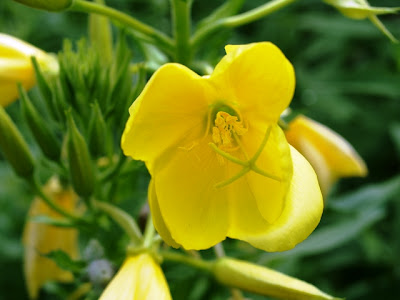Evening Primrose confusing and mixed-up
Our Evening Primroses are fading now, after weeks of adding a dash of
pale canary yellow to our backyard here at Kew Gardens. Like all Evening
Primrose they open on dull days (like today) and in the evenings, to be pollinated by hawk moths (with their famously long 'tongues') and other night insects.
We have a
common weedy species of Oenothera,
but which one? The Entwisle plants carry large flowers, about three inches across, and
no red veins on the leaves or sepals (sepals being the outer bits of the flower
– often, as in this case, the green bits). The stems do redden up occasionally
and there is a hint of pink on the edges of the sepals.
It was here last year so I’m going to call it an herbaceous biennial. Oenothera biennis (the Common Evening-primrose),
then, sounds good. However that species has flowers only two inches across at
most. There is Oenothera glazioviana
with bigger flowers, about the size of ours, but with red sepals. Like another
not dissimilar species, Oenothera
cambrica (with smaller flowers), its fruits have red hairs with swollen
bases. Our fruit hairs are swollen at the base but definitely not red.
So it has bits of various species, suggesting it may be a hybrid or
cultivar. There are some nice pictures on the Irish Wildflower site
for Oenothera biennis which match
ours beautifully, but they carry warning: ‘Photographs are not of Common
Evening-primrose, probably of a hybrid’.
As always, Tony Cope’s The Wild
Flora of Kew Gardens: a Cumulative Checklist from 1759 is helpful. He
mentions a hybrid called Oenothera x fallax, a cross between Oenothera biennis and Oenothera glazioviana. This hybrid has been
recorded from a ‘neglected flowerbed in Lower Nursery’ which describes bits of
our garden before we arrived, and certainly the meadow-like expanse next door.
Tony Cope says this hybrid may have escaped from cultivation or have
arisen on site through hybridisation of its parents which he says are rare
escapes from gardens. He gives it the common name of Intermediate Evening-primrose.
And then in the mail this week comes the latest issue of the Royal
Horticultural Society Magazine, The Garden,
with a feature of Evening Primrose. Graham Rice describes the ‘yellow biennial
evening primroses’ as a ‘confusing group based around Oenothera glazioviana’. He says this species crosses with other
species such as Oenothera biennis to create
a ‘mixed-up group of similar hybrids’. That’ll do me!
Whenever I hear the words ‘evening primrose’ I add the word ‘oil’. Also
called King’s Cure-all, Evening Primrose is said to have various powers of
healing and other good things. The seeds contain fatty acids that may, or may
not, help in the control of certain illnesses. The considered opinion at the
moment seems to be that clinical trials are inadequate to prove any real value
but the chemicals are interesting and worth pursuing further.
So I won’t be harvesting the seed for medicine but I’m happy for it to
spread a little further into the diminishing part of our garden that we can
called neglected.



Comments